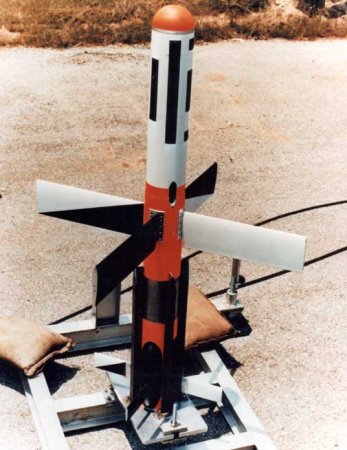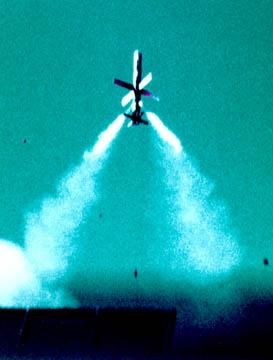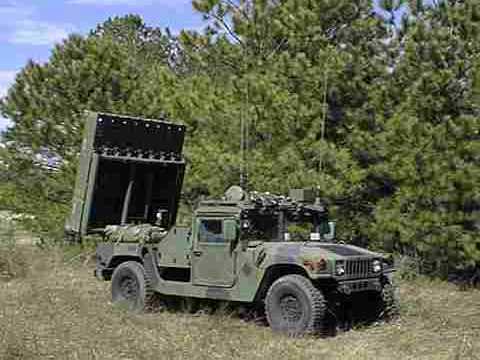美国FOG-M和“网火”是什么关系?后者有无线导型号?
来源:百度文库 编辑:超级军网 时间:2024/04/29 00:31:01
我是在07年5月号的舰载武器上看到的,不过只是提了一句,没有任何更详细的介绍了,只是说了这种导弹是一种与以色列长钉ER,德国的独眼巨人一类的巡飞弹,请问诸位谁手里还有详细的资料介绍啊?多谢了!
楼下是已经找到的
我是在07年5月号的舰载武器上看到的,不过只是提了一句,没有任何更详细的介绍了,只是说了这种导弹是一种与以色列长钉ER,德国的独眼巨人一类的巡飞弹,请问诸位谁手里还有详细的资料介绍啊?多谢了!
楼下是已经找到的
Raytheon MGM-157 EFOGM
The EFOGM (Enhanced Fiber Optic Guided Missile) was a U.S. Army ATD (Advanced Technology Demonstration) program to evaluate a fiber-optically guided precision anti-tank and anti-helicopter battlefield missile.
Development of EFOGM can be traced back to 1984, when the U.S. Army began the two-year FOG-M (Fiber Optic Guided Missile) demonstration program. The FOG-M used the motor of a BGM-71 TOW missile, had a TV camera in the nose and a fiber-optic cable instead of the conventional guidance wire. The cable acted as a data link which transmitted the camera's image to the operator, who could then send guidance commands to the missile. In November 1987, a request for proposals for a tactical FOG-M was issued to the industry, and in December 1988, a FOG-M development contract was awarded to a Boeing/Hughes team. However, the FOG-M program was cancelled in 1990.
In 1992, the FOG-M was revived as a technology demonstration program. In early 1994, the Army released a request for proposals for a new EFOGM (Enhanced FOG-M), and allocated the designation YMGM-157A to the missile. In May 1995, Raytheon was awarded a contract to develop the EFOGM. In August 1995, a so called Early Soldier Evaluation (ESE) was conducted by the U.S Army, which evaluated general system design and handling characteristics. Further simulations and evaluations followed through 1996, and all these preliminary studies have presumably led to some design changes in the EFOGM missile, because when the first missiles were flight tested in 1998, the designation had changed to YMGM-157B. The designation DMTM-157B applied to a completely inert version for ground handling training.

The YMGM-157B was launched vertically from an 8-missile launcher on an XM44 Fire Unit, based on the HMMWV (High Mobility Multipurpose Wheeled Vehicle). The missile was powered by a dual-thrust (boost/sustain) solid-fueled rocket motor, and could achieve a range of up to 15 km (9.3 miles). The EFOGM was a non-line-of-sight weapon, and could be launched at a target while the Fire Unit was protected behind a hill. The path to the general target area was programmed before launch by selecting several waypoints, and the missile would follow the preselected flight path using its Inertial/GPS guidance unit. The YMGM-157B had cruciform wings and tail fins for stabilization and control during its non-ballistic flight. For terminal guidance, the operator selected the exact point of impact by using the images of the CCD-based TV camera or the IIR (Imaging Infrared) sensor. These images were transmitted via the fiber-optic cable, which was spooled out from the missile. The operator could either manually control the EFOGM until impact, or lock the missile's tracker on a selected impact point. The EFOGM's shaped charge warhead was detonated by an impact fuze. Because the YMGM-157B flew at altitudes of about 300 m (1000 ft) above ground, armoured targets were attacked from the top, which is the most vulnerable area of tanks. The EFOGM could also be used against low-flying helicopters.


Several successful guided test flights of EFOGM were made through 1998 and 1999, and in 2000, the U.S. Army began the two-year EUE (Extended User Evaluation) phase of the program. The EUE was intended to demonstrate the operational deployment of an EFOGM Company. By June 2002 the EFOGM ATD (Advanced Technology Demonstration) was essentially complete, but the Army cancelled further funding of EFOGM, and so the program was terminated. A total of about 300 YMGM-157B missiles had been built for the EFOGM program.
Specifications
Note: Data given by several sources show slight variations. Figures given below may therefore be inaccurate!
Data for YMGM-157B:
Length 1.94 m (6 ft 4.4 in)
Wingspan 114 cm (44.9 in)
Diameter 16.6 cm (6.55 in)
Weight 53.3 kg (118 lb)
Speed 100 m/s (330 fps)
Range 15 km (9.3 miles)
Propulsion Dual-thrust solid-fueled rocket motor
Warhead Shaped charge
Raytheon MGM-157 EFOGM
The EFOGM (Enhanced Fiber Optic Guided Missile) was a U.S. Army ATD (Advanced Technology Demonstration) program to evaluate a fiber-optically guided precision anti-tank and anti-helicopter battlefield missile.
Development of EFOGM can be traced back to 1984, when the U.S. Army began the two-year FOG-M (Fiber Optic Guided Missile) demonstration program. The FOG-M used the motor of a BGM-71 TOW missile, had a TV camera in the nose and a fiber-optic cable instead of the conventional guidance wire. The cable acted as a data link which transmitted the camera's image to the operator, who could then send guidance commands to the missile. In November 1987, a request for proposals for a tactical FOG-M was issued to the industry, and in December 1988, a FOG-M development contract was awarded to a Boeing/Hughes team. However, the FOG-M program was cancelled in 1990.
In 1992, the FOG-M was revived as a technology demonstration program. In early 1994, the Army released a request for proposals for a new EFOGM (Enhanced FOG-M), and allocated the designation YMGM-157A to the missile. In May 1995, Raytheon was awarded a contract to develop the EFOGM. In August 1995, a so called Early Soldier Evaluation (ESE) was conducted by the U.S Army, which evaluated general system design and handling characteristics. Further simulations and evaluations followed through 1996, and all these preliminary studies have presumably led to some design changes in the EFOGM missile, because when the first missiles were flight tested in 1998, the designation had changed to YMGM-157B. The designation DMTM-157B applied to a completely inert version for ground handling training.

The YMGM-157B was launched vertically from an 8-missile launcher on an XM44 Fire Unit, based on the HMMWV (High Mobility Multipurpose Wheeled Vehicle). The missile was powered by a dual-thrust (boost/sustain) solid-fueled rocket motor, and could achieve a range of up to 15 km (9.3 miles). The EFOGM was a non-line-of-sight weapon, and could be launched at a target while the Fire Unit was protected behind a hill. The path to the general target area was programmed before launch by selecting several waypoints, and the missile would follow the preselected flight path using its Inertial/GPS guidance unit. The YMGM-157B had cruciform wings and tail fins for stabilization and control during its non-ballistic flight. For terminal guidance, the operator selected the exact point of impact by using the images of the CCD-based TV camera or the IIR (Imaging Infrared) sensor. These images were transmitted via the fiber-optic cable, which was spooled out from the missile. The operator could either manually control the EFOGM until impact, or lock the missile's tracker on a selected impact point. The EFOGM's shaped charge warhead was detonated by an impact fuze. Because the YMGM-157B flew at altitudes of about 300 m (1000 ft) above ground, armoured targets were attacked from the top, which is the most vulnerable area of tanks. The EFOGM could also be used against low-flying helicopters.


Several successful guided test flights of EFOGM were made through 1998 and 1999, and in 2000, the U.S. Army began the two-year EUE (Extended User Evaluation) phase of the program. The EUE was intended to demonstrate the operational deployment of an EFOGM Company. By June 2002 the EFOGM ATD (Advanced Technology Demonstration) was essentially complete, but the Army cancelled further funding of EFOGM, and so the program was terminated. A total of about 300 YMGM-157B missiles had been built for the EFOGM program.
Specifications
Note: Data given by several sources show slight variations. Figures given below may therefore be inaccurate!
Data for YMGM-157B:
Length 1.94 m (6 ft 4.4 in)
Wingspan 114 cm (44.9 in)
Diameter 16.6 cm (6.55 in)
Weight 53.3 kg (118 lb)
Speed 100 m/s (330 fps)
Range 15 km (9.3 miles)
Propulsion Dual-thrust solid-fueled rocket motor
Warhead Shaped charge
还是没人知道什么吗?
回复 1# 上平房
FOD-M是一种有线制导的导弹,这种导弹与独眼巨人,日本的96式类似,不过这种导弹好像很久没有露面了,我也只是在2000年5月的兵器知识上的一篇关于反坦克导弹的文章里看到的。从性能上看,这种导弹和美国在海尔法基础上发展的三军通用导弹以及网火导弹在性能上冲突,不清楚是怎么回事了就。
FOD-M是一种有线制导的导弹,这种导弹与独眼巨人,日本的96式类似,不过这种导弹好像很久没有露面了,我也只是在2000年5月的兵器知识上的一篇关于反坦克导弹的文章里看到的。从性能上看,这种导弹和美国在海尔法基础上发展的三军通用导弹以及网火导弹在性能上冲突,不清楚是怎么回事了就。
想起来了,03年5月份的航空知识也上提到过
.........
那是FOG-M Fiber Optic Guided Missile 吧?:L
http://www.designation-systems.net/dusrm/m-157.html
那是FOG-M Fiber Optic Guided Missile 吧?:L
http://www.designation-systems.net/dusrm/m-157.html
回复 6# raptor82
是的,楼主搞错了,把我也带歪了
是的,楼主搞错了,把我也带歪了
图1


图2


图3


看不懂啊
不知道哪个会成功 不过巡飞弹肯定有前途
回复 13# 月光水手服
不知掉网火有无线导型号
不知掉网火有无线导型号